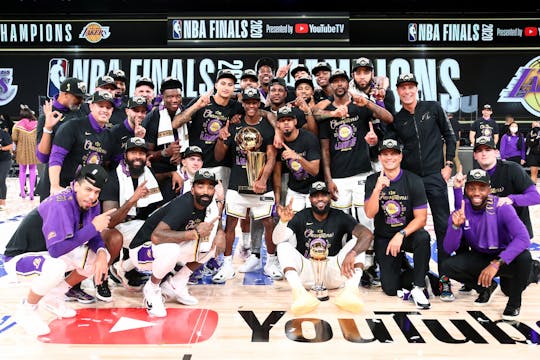Back in March 2020, the Los Angeles Lakers were on a roll.
They opened the month with a big win over the young New Orleans Pelicans led by former Lakers, Brandon Ingram and Lonzo Ball. They avoided a trap game against the undermanned Philadelphia 76ers, which set up LA’s biggest games of that season. The next two games were a true test to see if the Lakers were a true championship contender or not.
First up, they traveled out east to face the league-leading Milwaukee Bucks. LeBron James outplayed Giannis Antetokounmpo, proving that the young Buck still had a lot to learn before he could become the king of the NBA.
Next up, the Lakers played an “away” game against their new rivals, the LA Clippers. It was a tight game between both teams but in the end, James and Anthony Davis outplayed Kawhi Leonard and Paul George to get the statement win.
The Lakers were on a high. They had a borderline top 10 offense and a top three defense, making them one of the best teams in the league. They were well on their way to a dominant postseason run.
Then the world stood still.
The state of the NBA
NBA fans can still remember March 11, 2020.
What was supposed to be a run of the mill regular season game between the Oklahoma City Thunder and the Utah Jazz became the trigger that would force the league to take wide-spread action.
After Rudy Gobert tested positive for COVID-19, the NBA was forced to postpone not only the Thunder-Jazz game that day, but all subsequent games after the conclusion of that game day. In order to protect the fans, players, coaches, team staff, and league personnel, the NBA decided to suspend the season until it was safer to resume play.
It was several months of waiting. And waiting. And waiting.
During that pause, the NBA outlined their pandemic policies and prepared a safer way to resume the season. Finally, in July, the league had a game plan. They would resume the season in a bubble set-up to ensure the safety of everyone that would take part in the games.
With that, the Lakers and 21 other teams made their way to Disney World in Orlando to finish the abbreviated 2019-2020 season.
The lineup
At their best, the Lakers were a machine – a team that was built to maximize the talents of James and Davis on both ends of the floor.
Offensively, the King and the Brow terrorized opponents as the most potent pick-and-roll combo in the league.
Davis was one of the best finishers in the game during that season, averaging 26 points on 50 percent shooting. He was an athletic freak that could finish with finesse or through contact. More importantly, Davis could pop out in the perimeter where he was also comfortable hitting the outside shot or putting the ball on the floor and taking it strong to the hoop.
Giving someone like James a target like Davis made him even better. He picked apart defenses with his passing that season, leading the league in assists at 10.2 per game. If teams stayed home on his targets, James could easily take his defender one-on-one with a bevy of moves.
James and Davis were surrounded by shooters like Kentavious Caldwell-Pope, Danny Green, Markieff Morris, Kyle Kuzma, and JR Smith to ensure that they would have enough spacing to work their two-man game.
As good as they were offensively, the team’s calling card that season was their menacing defense.
The Lakers were the third best defensive team in the league in terms of their defensive rating. They limited opponents to 107.6 points per game on 44.8 percent shooting, all well below league average numbers (111.8 PPG, 46% FG).
Their defense relied on being able to switch seamlessly while also having the size to win the battle in the paint. James and Davis at 6’9” and 6’10” respectively played big roles on defense. The two were nimble enough to stay in front of their opponents out in the perimeter, athletic enough to recover when they got beat, and big enough to man the shaded lane.
With the team’s two best players all in on defense, everyone else followed.
Dwight Howard and JaVale McGee were the bash brothers of the team. They did the dirty work in the paint and exerted more effort to defend in space. Alex Caruso was a revelation that season as the team’s best perimeter defender, often supercharging the team with energy plays that lead to extra possessions.
The Lakers benefitted from the time off before the bubble. That team was the second-oldest team in the league coming into the season with an average age of 29 years old. The nearly five-month break allowed the Lakers to rest their older legs and heal up from the injuries of the regular season grind before the season was suspended.
The aftermath
The Lakers entered the bubble refreshed and were supposed to pick up where they left off. Unfortunately, that wasn’t the case. During the eight seeding games that they played, they looked rusty and struggled to find a rhythm. It was obvious that they were still finding their legs after months of not playing competitive basketball.
They managed to win only three of their eight seeding games. While those three wins were enough to secure the top seed in the West, it was a cause of genuine concern that the dominant team back in March was nowhere to be found in Florida. The Lakers looked like a middling team with no identity. Their once stout defense was suddenly porous, allowing 113 points per game during that stretch.
The Lakers looked like they were in trouble. Analysts counted them out, eliminating them early from their projected playoff brackets. Fans were worried that the midseason break killed all of their momentum and that their team was dead in the water.
Once the playoffs started, it was clear that the Lakers fooled everyone with their rope-a-dope during the seeding games, rolling through their side of the Western Conference bracket with ease.
They shut down the Portland Trail Blazers, led by seeding games MVP Damian Lillard, winning the series in five games. Against the super small-ball Houston Rockets, the Lakers proved that height and length still mattered in the league, bullying them in five games with a creative defensive strategy that made use of their collective length as a team.
The dream matchup against the Clippers never materialized, instead they were matched up against the up-and-coming Denver Nuggets led by Nikola Jokic. Davis owned Jokic in the five-game series. He not only made the Joker’s life miserable, he also earned himself a playoff moment with his walk off game-winner in Game 2.
The 2020 NBA Finals was actually kind of anti-climactic at that point. The Lakers looked unstoppable and the overwhelming favorites to win the Finals. The Miami Heat gave them everything that they had and were the only team that season to take the Lakers to six games. But in the end, LeBron James stamped his class in the series and took home the Finals MVP as proof of his supremacy.
It’s been two years since the Lakers won the crown in the bubble but up to now, the legitimacy of their championship is still being questioned. People are placing an asterisk on the Lakers’ win, claiming that the unique circumstances of that season made that championship less of a “real” win. That debate won’t end. Haters will still use the Mickey Mouse ring as a way to tear the team down.
At the end of the day, the record books will show that in 2020, the Los Angeles Lakers won the NBA championship. And because of everything that was happening in the world during that year, their championship will be one of the most memorable ones in the history of the league. Even if you think it’s legit or not.




